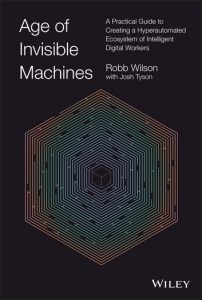What happens when you allow anyone in your organisation to start automating processes without a need to have coding skills?
Even more magic will appear when you set the bar higher than just making the machines do the manual routine work but to create user experiences and workflows that exceed human capabilities.
Gartner coined the term hyperautomation in 2019, and it’s one of their top strategic trends for this year.
Robb Wilson’s latest book, Age of the Invisible Machines, talks about using conversational AI as the interface tool for anything and everything in the automation ecosystem. It’s the concierge layer that hides all the complexity and intelligence beneath it.
Machines should accommodate to the context and user preferences and should be agnostic to different channel media. If you prefer to use voice that should be as natural way to interact as typing and chatting, as the other means to communicate.
Hyperautomation aims to become self-learning with the help of humans and even make the entire organisation redundant and replaceable by DAOs and other decentralised service layers.
Anyone who has used Siri, Alexa or numerous corporate chatbots is familiar with the task ahead. Predetermined selection trees and FAQ pages converted to chat prompts are not exactly a pleasant or delightful user experience.
Wilson says that deep learning, blockchain and code-free development tools will disrupt all businesses very soon. He compares the amount of change to the invention of the printing press and the industrial revolution.
Some of the incumbents are starting to restructure their companies around user interaction: Salesforce builds its entire company around its acquisition, Slack. Microsoft centres Teams as the core product that the rest will interface with and serve.
Ant Group from China is an operational example of hyperautomation. It has 450 million active users that get their loans approved, credits scored and funds distributed without human intervention. When you structure your company around the better-than-human user experience (Wilson’s term) and have the capabilities to create new micro-services and tasks with flexibility and dynamically it sets your company in a different innovation clock speed. The goal is to test, learn and adapt.
Decentralised micro-services and skills are familiar from the DeFi world where composability with money legos have enabled rapid innovation, creation and ecosystems of services that were not even dreamt of a few years earlier.
Wilson has been kickstarting the user experience driven hyperautomation with his company Onereach.ai for years. How open and flexible ecosystem they are able to build remains still to be seen but the trend towards decentralisation and away from proprietary and closed ecosystems is here to stay.

